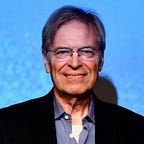Filmed Theatre or Cinema?
And how the term “prep” reveals a faulty mindset.
There have been masters in cinema who have worked in theatre and there have been those who haven’t. There are teachers of filmmaking who went to theatre school or worked in theatre and still think that way and there are those that didn’t and don’t.
Ophuls, Mizoguchi, Bergman, virtuosi of cinematic language, were also adept in the discourse of the stage. Even Ken Loach was interested in plays before he was drawn to movies. Hitchcock, Dreyer, Godard were by contrast cineastes pure and simple. Ramsey, Arnold, Martel are some of the many contemporary directors whose cinephilia, so far as I understand, has needed little or no nourishment from the stage.
I can think of filmmaking educators who think cinema is theatre with a camera pointed at it — or rather, they don’t think, they assume. Thus they differ from the best exponents of both art forms who understand the nature of each.
I’ve heard that the Prague Film School, decades ago, wouldn’t allow first year directing students anywhere near a camera. Their first task, it was understood, was to elicit performance without regard for the screen. This may as well have been a theatre program. Performances and staging established, the next step, by inference a subsidiary step, inferior to the physical production of an event was seen as the recording of the action on film and its piecing together.
It’s purely what’s in front of the camera on set or on location that matters is the supposition here. That’s when and where it happens. This is theatre with camera and editing added.
Such a mindset leads to further misplaced thinking…
Fix it in prep! Fix it in post! So they say. Fix what? And why fix? Why prep? And what does it mean?
Let’s first consider prep. What does this term suggest but the assumption that nothing actually happens until the actors arrive on set. That’s wrong. The decision-making that occurs in the shoot by no means marks the beginning of the filmmaker’s work, which may start as soon as they conceive of the idea of their film, or write the screenplay, first encounter a draft of one or collaborate with a writer on their script.
Preparation is not preliminary to the making of the movie but is part and parcel of that making.
Prep might be better described as formulation, a process through which nothing is fixed but everything is developed, the time when visualization in part and in whole comes together, when sets are designed and locations chosen, and when casting occurs — in itself the foundation for performance.
These tasks continue with the shoot, with the discovery on set of revisions and improvements of planned staging and shooting, with the actors’ and director’s conjuring of performance, and with the input of circumstance and the unanticipated vicissitudes, accidents,, and sundry surprise offerings the universe tends to provide. Even with the best formulation this can prove the filmmaker’s ‘thinking on one’s feet’ stage.
Next comes post. Forget the term fix. You don’t fix things in post. Post is not triage. It’s not mere salvage. Or rather it shouldn’t be. This is where the filmmaker travels further along their symbiotic journey of intention and discovery. Where, through editorial art, the elements of storytelling, emotion, and meaning, take flight. Where sound design modulates and vivifies the world of the movie. Where, at last, the film gets the upper hand over the filmmaker and in the best of circumstances says This is what I am.
Throughout the entire process, the making of the film is both realization and evolution, evolution and realization. Not merely the mounting of a production on set and its “coverage”.
Michael Powell and Emeric Pressburger’s 1948 The Red Shoes, contains a breathtaking ballet sequence that in the way it morphs from a front-on view of a proscenium arch stage to dazzling cinematic montage reveals a profound understanding of the natures of theatre and film. Here, the representation of a theatre event is transformed into the artifact that constitutes a movie.
Space and time, constants in the physical world of the theatre, give way to their modulated and manipulated cinematic counterparts. What never happened as a complete scene on set comes to fictional life on the screen.
Complete scenes can of course happen on set or location. Complete movies even, as is the case with Balint Kenyere’s astounding short Before Dawn, shot in a breathtaking single take by cinematographer Matyas Erdely. Without pre-visualization however, without rigorous, forensic formulation — the creative work of several cinematic minds — such a powerful work could not have been achieved. It was in the formulation that the vision of the film found its form. Its execution, even if the skill involved beggars belief, was purely technical and practical.
Hitchcock even once commented he wished that once he had a film together in his head, there would be no need to make it. Luckily for us, he was denied his inclination!
Nevertheless, as his mindset shows us, the master made cinema, not filmed theatre…
Peter Markham July 2023
Author:
The Art of the Filmmaker: The Practical Aesthetics of the Screen. (OUP) 10/23
What’s the Story? The Director Meets Their Screenplay. (Focal Press/Routledge) 9/20
. . .
Thank you for reading. Please comment! Your questions and critiques are greatly appreciated.
